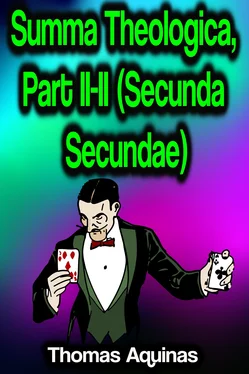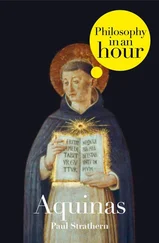Reply Obj. 6: Two things may be considered in the sacrament of the Eucharist. One is the fact that it is a sacrament, and in this respect it is like the other effects of sanctifying grace. The other is that Christ's body is miraculously contained therein and thus it is included under God's omnipotence, like all other miracles which are ascribed to God's almighty power. _______________________
NINTH ARTICLE [II-II, Q. 1, Art. 9]
Whether It Is Suitable for the Articles of Faith to Be Embodied in a
Symbol?
Objection 1: It would seem that it is unsuitable for the articles of faith to be embodied in a symbol. Because Holy Writ is the rule of faith, to which no addition or subtraction can lawfully be made, since it is written (Deut. 4:2): "You shall not add to the word that I speak to you, neither shall you take away from it." Therefore it was unlawful to make a symbol as a rule of faith, after the Holy Writ had once been published.
Obj. 2: Further, according to the Apostle (Eph. 4:5) there is but "one faith." Now the symbol is a profession of faith. Therefore it is not fitting that there should be more than one symbol.
Obj. 3: Further, the confession of faith, which is contained in the symbol, concerns all the faithful. Now the faithful are not all competent to believe in God, but only those who have living faith. Therefore it is unfitting for the symbol of faith to be expressed in the words: "I believe in one God."
Obj. 4: Further, the descent into hell is one of the articles of faith, as stated above (A. 8). But the descent into hell is not mentioned in the symbol of the Fathers. Therefore the latter is expressed inadequately.
Obj. 5: Further, Augustine (Tract. xxix in Joan.) expounding the passage, "You believe in God, believe also in Me" (John 14:1) says: "We believe Peter or Paul, but we speak only of believing 'in' God." Since then the Catholic Church is merely a created being, it seems unfitting to say: "In the One, Holy, Catholic and Apostolic Church."
Obj. 6: Further, a symbol is drawn up that it may be a rule of faith. Now a rule of faith ought to be proposed to all, and that publicly. Therefore every symbol, besides the symbol of the Fathers, should be sung at Mass. Therefore it seems unfitting to publish the articles of faith in a symbol.
On the contrary, The universal Church cannot err, since she is governed by the Holy Ghost, Who is the Spirit of truth: for such was Our Lord's promise to His disciples (John 16:13): "When He, the Spirit of truth, is come, He will teach you all truth." Now the symbol is published by the authority of the universal Church. Therefore it contains nothing defective.
I answer that, As the Apostle says (Heb. 11:6), "he that cometh to God, must believe that He is." Now a man cannot believe, unless the truth be proposed to him that he may believe it. Hence the need for the truth of faith to be collected together, so that it might the more easily be proposed to all, lest anyone might stray from the truth through ignorance of the faith. It is from its being a collection of maxims of faith that the symbol [*The Greek symballein ] takes its name.
Reply Obj. 1: The truth of faith is contained in Holy Writ, diffusely, under various modes of expression, and sometimes obscurely, so that, in order to gather the truth of faith from Holy Writ, one needs long study and practice, which are unattainable by all those who require to know the truth of faith, many of whom have no time for study, being busy with other affairs. And so it was necessary to gather together a clear summary from the sayings of Holy Writ, to be proposed to the belief of all. This indeed was no addition to Holy Writ, but something taken from it.
Reply Obj. 2: The same doctrine of faith is taught in all the symbols. Nevertheless, the people need more careful instruction about the truth of faith, when errors arise, lest the faith of simple-minded persons be corrupted by heretics. It was this that gave rise to the necessity of formulating several symbols, which nowise differ from one another, save that on account of the obstinacy of heretics, one contains more explicitly what another contains implicitly.
Reply Obj. 3: The confession of faith is drawn up in a symbol in the person, as it were, of the whole Church, which is united together by faith. Now the faith of the Church is living faith; since such is the faith to be found in all those who are of the Church not only outwardly but also by merit. Hence the confession of faith is expressed in a symbol, in a manner that is in keeping with living faith, so that even if some of the faithful lack living faith, they should endeavor to acquire it.
Reply Obj. 4: No error about the descent into hell had arisen among heretics, so that there was no need to be more explicit on that point. For this reason it is not repeated in the symbol of the Fathers, but is supposed as already settled in the symbol of the Apostles. For a subsequent symbol does not cancel a preceding one; rather does it expound it, as stated above (ad 2).
Reply Obj. 5: If we say: "'In' the holy Catholic Church," this must be taken as verified in so far as our faith is directed to the Holy Ghost, Who sanctifies the Church; so that the sense is: "I believe in the Holy Ghost sanctifying the Church." But it is better and more in keeping with the common use, to omit the 'in,' and say simply, "the holy Catholic Church," as Pope Leo [*Rufinus, Comm. in Sym. Apost.] observes.
Reply Obj. 6: Since the symbol of the Fathers is an explanation of the symbol of the Apostles, and was drawn up after the faith was already spread abroad, and when the Church was already at peace, it is sung publicly in the Mass. On the other hand the symbol of the Apostles, which was drawn up at the time of persecution, before the faith was made public, is said secretly at Prime and Compline, as though it were against the darkness of past and future errors. _______________________
TENTH ARTICLE [II-II, Q. 1, Art. 10]
Whether It Belongs to the Sovereign Pontiff to Draw Up a Symbol of
Faith?
Objection 1: It would seem that it does not belong to the Sovereign Pontiff to draw up a symbol of faith. For a new edition of the symbol becomes necessary in order to explain the articles of faith, as stated above (A. 9). Now, in the Old Testament, the articles of faith were more and more explained as time went on, by reason of the truth of faith becoming clearer through greater nearness to Christ, as stated above (A. 7). Since then this reason ceased with the advent of the New Law, there is no need for the articles of faith to be more and more explicit. Therefore it does not seem to belong to the authority of the Sovereign Pontiff to draw up a new edition of the symbol.
Obj. 2: Further, no man has the power to do what is forbidden under pain of anathema by the universal Church. Now it was forbidden under pain of anathema by the universal Church, to make a new edition of the symbol. For it is stated in the acts of the first* council of Ephesus (P. ii, Act. 6) that "after the symbol of the Nicene council had been read through, the holy synod decreed that it was unlawful to utter, write or draw up any other creed, than that which was defined by the Fathers assembled at Nicaea together with the Holy Ghost," and this under pain of anathema. [*St. Thomas wrote 'first' (expunged by Nicolai) to distinguish it from the other council, A.D. 451, known as the "Latrocinium" and condemned by the Pope.] The same was repeated in the acts of the council of Chalcedon (P. ii, Act. 5). Therefore it seems that the Sovereign Pontiff has no authority to publish a new edition of the symbol.
Obj. 3: Further, Athanasius was not the Sovereign Pontiff, but patriarch of Alexandria, and yet he published a symbol which is sung in the Church. Therefore it does not seem to belong to the Sovereign Pontiff any more than to other bishops, to publish a new edition of the symbol.
Читать дальше












